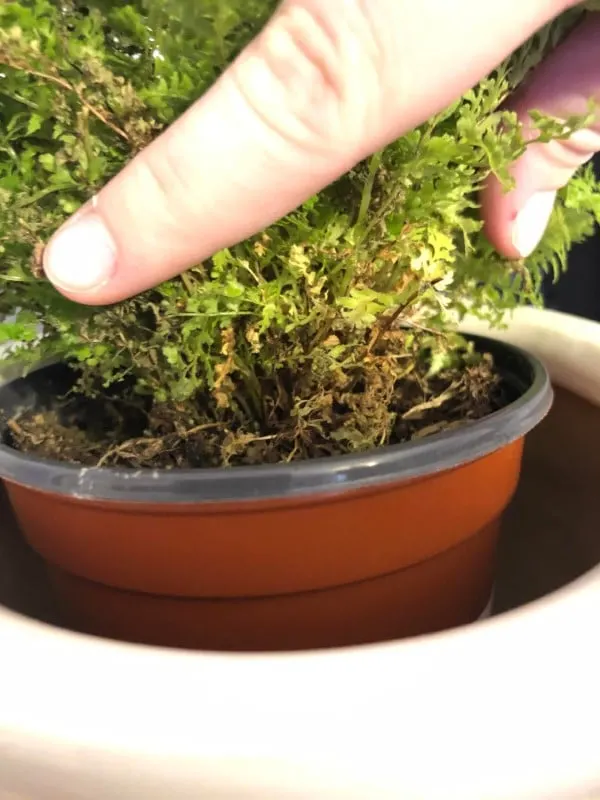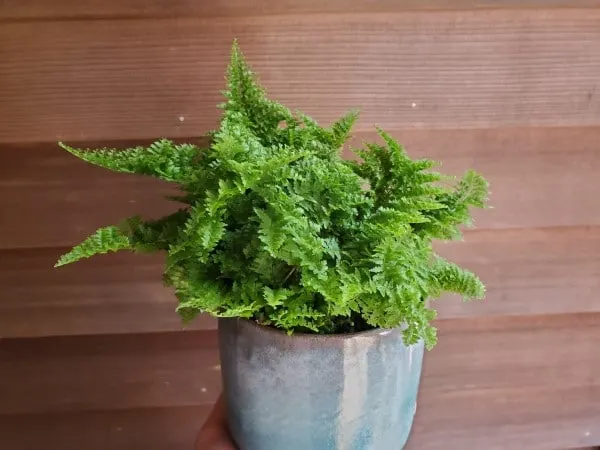As far as you’re concerned, a Cotton Candy Fern’s Latin name is Nephrolepis exaltata. It is also known as Suzi Wong fern or Fluffy Ruffle fern.
It belongs to the evergreen family Lomariopsidaceae (sometimes treated in the Nephrolepidaceae, Oleandraceae, or Davalliaceae) and originated from tropical areas around the world.
Resembling cotton candy, this attractive, lush houseplant rewards gardeners without considerable maintenance and care. Under ideal conditions, the plant can thrive up to 5 feet tall at its maturity.

If you are attracted to the beauty of Cotton Candy fern, keep scrolling to find out favorable information about the plant and several caring tips to keep your plant alive and thriving. So, don’t miss out!
Cotton Candy Fern: An Overview
- Common name: Cotton Candy fern, Fluffy Ruffle fern, Suzi Wong fern
- Scientific name: Nephrolepis Exaltata ‘Smithii’
- Family: Lomariopsidaceae
- Genus: Sword fern
- Origin: Tropical forests and swamps
- Zones: USDA Zones 9-11
- Growth habit: Upright, can grow up to 2–3 feet tall
- Life cycle habit: Perennial
- Care level: Easy
- Characteristics:
- Frond: Soft, vibrant, fluffy fronds that outwards as they grow.
- Shape: Grow in the shape of the rosette.
- Flowers: Ferns are plants that do not produce flowers or seeds.
- Mature specimen reproduce sexually from spores on the underside of the leaves.
- Growing: Indoors, hanging baskets, outdoors in large containers
- Toxicity: Cotton Candy fern is non-toxic and pet-friendly. Thus, you don’t have to fret when your kids or pets accidentally eat the fern.
8 Essential Factors To Consider When Caring Of Cotton Candy Fern
Although a Cotton Candy fern is generally low-maintenance and easy to maintain indoors, it requires appropriate lighting, water, humidity, and several essential factors to ensure its health and luscious green fronds year-round.
So, delve deeper into the complete guide below to learn some practical tips for caring for your Cotton Candy fern.
However, note that the recommendations can be personalized depending on the area where you live and the plant’s requirements.
1. Soil
Cotton Candy fern requires retentive moisture soil but should not submerge in water. Poorly drained soil can lead to root rot, causing the plant to die. Therefore, the plant has desirable demands for its substrate.
- Covered in a thick layer of humus
- Good drainage
- pH level: Slight acidic
- Sufficient nutrient content
- Water-permeable

Hence, you can use conventional potting soil or mix up your recipe using 1 part peat moss, 1 part coarse or builder sand, and 1 part garden topsoil.
2. Lighting
Although this kind of fern thrives in nature with semi-shade or even in the shadow of trees, it flourishes in bright, indirect sunlight when growing indoors.
Therefore, it is ideal for placing the plant in an area that receives indirect morning sun, particularly the East or West window. Also, partial shade in the afternoon is suggested for the plant to avoid burning the fronds.
Besides, you can either use sheer curtains on the window or blinds to control the amount of sunlight touching the plant.
3. Temperature
Cotton Candy fern prefers mild temperatures ranging from 60 and 80 degrees Fahrenheit. Hence, it cannot tolerate freezing temperatures or scorching climates. Temperatures rising above 95 °F can burn the fronds, while temperatures below 35 °F can stunt the plant’s growth.
Noteworthy, avoid sudden temperature changes from air conditioning, drafts, cold breezes, or heaters.
4. Humidity
High humidity is a critical factor for the development of Cotton Candy fern. It grows best in humidity levels above 80%. Thus, it grows well in the kitchen or bathroom.
If the plant is dealing with low humidity in your house, its fronds may develop brown edges and tips. But don’t fret. Try some hassle-free tips below to combat the effects of dry air and naturally raise the humidity levels for the houseplant.
- Humidifier: It is significantly essential to add extra humidity around the plant.
- Mist: Regularly misting the plant, especially during the beginning of the winter season, to naturally bring the moisture back into the plant.
- Group the plants: Arrange several plants in a group to create a microclimate effect of humidity through a transpiration process.
- Pebble tray: Use a clean tray and fill the tray with enough water and pebbles. Then, place the plant pot in the pebbles. But remember not to let the pot submerge in water or else it will end up in root rot.
5. Watering
When the soil shows a sign of drying out, the fern’s foliages can turn yellow and droop. Hence, it is vital to keep the soil moist by watering the plant frequently.

The plant often requires plenty of water to remain damp in the summertime. But make sure to drain excess water as continuous waterlogging can lead to root rot. On the other hand, you can reduce watering during the fall and winter months as the fern is not actively growing and needs a break.
6. Fertilizer
It’s unnecessary to provide additional fertilizers for a new potted fern during the first year because fresh substrate can contain adequate nutrients for the plant to flourish.
The ideal time to feed the fern is from the spring to early fall as this is its active growing season. Add fertilizer to the fern with a 15-5-15 (nitrogen, phosphates, potassium) once every four weeks. No fertilization is needed in the late falls and winter months.
7. Propagation
Like other ferns, Cotton Candy fern can be propagated flawlessly by several methods, preferably in early spring when the plant has new growth.
1. Rhizomes
- Start by watering the plant thoroughly a couple of days before the process.
- Gently cut off a rhizome section of the fern with at least one frond attached. It is perfect if these rhizome parts have already produced roots.
- Provide sections with water and nutrients for the best results.
2. Division
Mature and healthy Cotton Candy fern can be easily propagated through division.
- Carefully dig up or remove the mature plant from its container.
- Use a sharp knife to cut between the rhizomes and divide the plant into 2 or 3 clumps.
- Remove dead roots and leaves.
- Repot separate pieces planted in individual pots using a high-quality potting mix.
- Water the new division thoroughly while the new plant establishes.
3. Spores
If you notice green, yellow, black, or brown dust-like particles on the underside of the fronds, those are spore cases. Spores contain genetic material capable of giving rise to a new fern.
When these small capsules are ripe, the cases open, and the spores expose.
- To collect the spores, remove the front and wrap it up in white paper.
- After a day or two, the spores are likely to fall into the paper.
- After collecting the spores, prepare a peat mixture and vermiculite in an unglazed pot.
- Add the spores to the mixture and cover with a plastic lid or plastic wrap to prevent contamination.
- Place the pot in a sunny, warm location with bright, indirect sunlight. Keep the spores moist but not soggy.
After four to six weeks, small, green fronds may emerge from the substrate, and the life cycle of fern continues. When the new ferns are ready, transplant them into individual containers and provide sufficient care.
8. Transplantation
Ideally, Cotton Candy fern can be transplanted in fall or spring before the new growth starts. It is recommended to repot the plant, particularly when it has outgrown its pot or the roots are poking out of the soil. Generally, the plant needs to be repotted every few years.
- Water the fern a few days before repotting to hold the moist soil onto the roots, thus facilitating easier transplanting.
- Select a new container that is one size larger than the current one and has excellent drainage holes.
- Dig a hole around the fern and lift the whole fern clump in one piece.
- Fill the new pot with 1 to 2 inches of fresh potting soil high in organic content at the bottom.
- Place the fern in the new container. The fern base should be at the same depth as the previous container. Planting too deeply may hinder the plant’s development and cause root rot.
- Locate the fern in a place with indirect light to create favorable conditions for the plant to thrive after the transplant.
- Water the fern appropriately and continue regular care.
The Final Words
Cotton Candy fern is a highly adaptable plant, and its attractive fronds can add an exotic charm to your room. However, although the fern can survive with little care and occasional neglect, it’s encouraged to supplement the plant with appropriate lighting, humidity, water, temperature, and other prerequisites for its healthy and gorgeous growth.
That’s said, it’s worth practicing a plant care routine to enjoy a fresh, flourishing plant in your house. We hope that even those new to gardening and houseplant can leverage the growing and caring techniques with ease.
Last but not least, if you have further concerns about the topic, feel free to drop a message. Also, if you enjoy the post, share it with your friends or loved ones.
